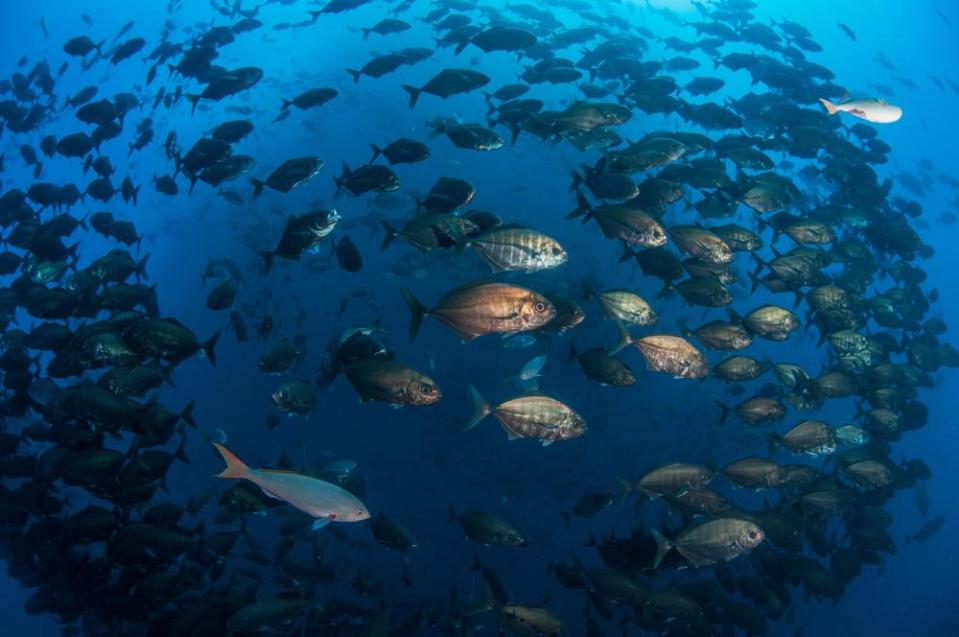Here’s proof fishing bans leave plenty to eat, says study of Mexico marine park
Banning fishing in a Mexican marine park did not reduce the fishing catch, according to a new study that says it has dispelled the “myth” spread by fishing companies that protecting marine areas leaves less fish available for people to eat.
The before-and-after study looked at whether banning commercial fishing from the Revillagigedo national park, which covers 147,000 sq km (57,000 sq miles) of Pacific Ocean west of Mexico, would reduce the country’s catch volumes.
The answer was no, said the study’s authors, who said the finding showed that “large, fully protected MPAs [marine protected areas] can contribute to a more sustainable and equitable use of the ocean, without major economic repercussions on the fishing industry”.

Before fishing in the MPA was banned in 2017, Mexico’s $1bn fishing sector had warned it could reduce their catch of tuna and other pelagic fish by 20%.
But catch data comparisons from the four years before and after the ban showed the MPA “had no causal effect on catches or area use, and therefore did not cause harm [to the Mexican fishing fleet]”, said Fabio Favoretto, a postdoctoral scholar at Scripps Institution of Oceanography in San Diego, California, and the lead author of the peer-reviewed study, published in the journal Science Advances.
One reason for the MPA’s apparently minimal impact on commercial fishing, he said, might be that the protected area “was almost insignificant” compared with the expanse of ocean available to the Mexican fleet.
Another “highly speculative” conclusion might be the existence of more fish in the areas around, as well as inside, MPAs, caused by a “spillover effect” into the surrounding seas, he said, adding that the research team aimed to look at this issue in its next study.
The worst enemy of the fishing sector is not protected areas – it’s overfishing
Enric Sala
Favoretto said it was not possible that significant levels of fishing could have continued undetected in the protected area, with boats potentially killing their transponder signals before entering the park.
“Because we were able to see the fishing activity elsewhere, so we didn’t have gaps [in the activity data], we saw them somewhere else,” he said.
By law Mexico’s fishing fleet is required to carry vessel monitoring system (VMS) transponders, which must be left on and are physically difficult to turn off, Favoretto said. “You can switch off AIS [another boat tracking system], but you cannot switch off VMS, and our data is from the VMS.”

He said that neither had there been any significant displacement of fishing activity to other areas. “We looked at the displacement effect, but there was not more of that,” he said, adding that ships were not going out further than before, with the fleets apparently catching the same volume of fish in a reduced area.
Illegal fishing during the four years was minimal as well, the researchers found, with average fishing activity within the MPA declining by 82%. Infractions were higher just after the ban, Favoretto said, and dropped to zero once a specialised marine crime monitoring programme called Skylight was fully implemented in 2021.
“I was surprised there was not more illegal fishing … and this is another message [from the study],” he said, adding that compliance was unexpectedly high.
The idea that MPAs might mean more, not less, fish for fleets is not new, said Enric Sala, one of the study’s co-authors and the National Geographic Society’s explorer-in-residence.
“A study last year showed the yellowfin tuna catch around the Papahānaumokuākea Monument, [the world’s largest no-fishing zone, off the coast of Hawaii] increased by 54%,” he said.
Sala added: “It’s really a myth that we can’t protect more of the ocean because we need more fish to feed more people. The global fishing catch has been declining since the mid-90s, yet only 3% is protected from fishing. The worst enemy of the fishing sector is not protected areas, it’s overfishing.”
Measuring the fish population in and around the Revillagigedo MPA, which protects humpback whales, whale sharks, silky sharks and manta rays, is the researchers’ next goal. They hope to see more MPAs, too.
Related: ‘Feeble’ curbs will ban bottom trawling in only three marine parks in England
“Last year at Cop15, the countries agreed to [protect] 30% of the oceans by 2030. If Mexico wants to meet that goal, it will need two to four more Revillagigedos,” said Octavio Aburto, a third co-author and Scripps’ professor in marine biology and biological oceanography.
However, there is no single model of MPA, Aburto said. The Revillagigedo national park MPA was helpfully situated far from land and people, which helped minimise threats and made policing easier, he said. MPAs closer to where people lived would need a “completely different conservation strategy”, he said.

 Yahoo Sports
Yahoo Sports 